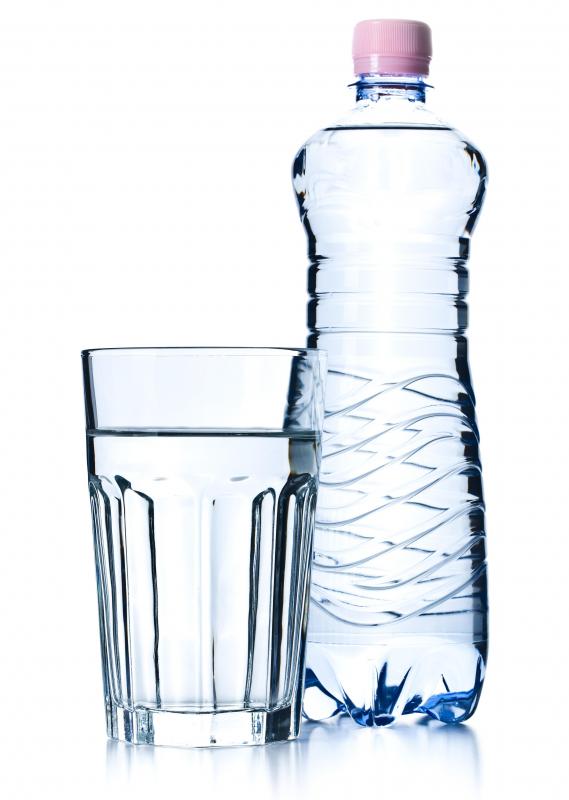At WiseGEEK, we're committed to delivering accurate, trustworthy information. Our expert-authored content is rigorously fact-checked and sourced from credible authorities. Discover how we uphold the highest standards in providing you with reliable knowledge.
What is the Relationship Between Fluid and Electrolytes?
The human body contains fluid both within its cells, called intracellular fluid (ICF), and outside its cells, called extracellular fluid (ECF). The two types of ECF are blood plasma and interstitial fluid, which is found in the microscopic spaces between cells. All body fluids contain electrolytes, which are atoms that have a positive or negative charge and are essential to the function of the nervous system and muscles, including the heart, and for maintaining blood pressure and the body's acid-base balance, or potenz hydrogen (pH) levels. The lungs, kidneys and hypothalamus play major roles in regulating the levels of fluid and electrolytes in the body, as does osmosis. An imbalance between the body's fluid and electrolytes can lead to severe illness or death.
There are five major electrolytes in the human body. They are sodium (Na+), which helps nerve cells send signals to each other and helps maintain electrolyte balance; potassium (K+), which helps nerves and muscles function and helps maintain the pH of body fluids; calcium (CA2+), which plays a role in blood clotting and nerve and muscle function; chloride (Cl-), which serves as a balance against positive ions; and bicarbonate (HCO3-), which helps maintain the proper pH in body fluids. Sodium, potassium and calcium are cations, or positively charged ions, and chloride and bicarbonate are anions, or negatively-charged ions. Ions have a positive or negative charge, so they can affect the pH of the body's fluids. The body can tolerate only very little alteration of the pH of its fluids and still function properly, so balanced electrolytes levels are necessary for survival.

Severe dehydration causes the kidneys to stop excreting fluid in an effort to prevent further fluid loss. This causes an imbalance in electrolytes that leads to metabolic acidosis, a condition in which the pH of the body's fluids is too low. Acidosis causes rapid breathing, lethargy and confusion, and it can lead to shock and death. An extreme loss of Cl- because of prolonged vomiting leads to metabolic alkalosis, in which the pH of the body's fluids is too high. Signs and symptoms of alkalosis include confusion, muscle twitches or spasms, a lightheaded feeling, nausea and tingling in the hands or face and coma.

The kidneys help maintain electrolyte balance by controlling how much fluid and electrolytes are released in the urine, and the lungs remove carbon dioxide from the blood, which makes the blood less acidic. This is why someone who has acidosis breathes rapidly to correct the condition and why hyperventilation can lead to respiratory alkalosis. Excessive use of sedative drugs can slow the breathing process enough to cause respiratory acidosis.

In addition to maintaining fluid levels and pH, the body also must maintain a healthy concentration of fluid and electrolytes between ICF and ECF. Water moves across cell membranes through a passive process called osmosis, which works to maintain the same concentration of fluid and electrolytes, especially Na+, inside and outside the cell membrane. If there is a higher concentration of Na+ outside the cell, water will move from ICF to ECF to balance the concentration. Too much of this movement of water causes the cells to become dehydrated, the blood pressure to rise and the brain's hypothalamus to trigger a feeling of thirst. This is called osmotic thirst, and it is why a person feels thirsty after eating salty foods.
When the same person drinks water, the concentration of Na+ in the blood drops and water flows back into the cells, restoring the balance of fluid and electrolytes. As a person loses body fluid through sweating, urinating, vomiting, diarrhea or bleeding, another type of cell within the hypothalamus triggers thirst to replace fluid volume. This is called hypovolemic thirst.
The passive process of osmosis and the functions of the lungs and kidneys work together to maintain the right levels of fluids and electrolytes within the body. This ensures that each electrolyte can do its job of keeping the heart beating and the nervous system functioning. Too much or too little of an electrolyte can cause serious problems. For example, too little K+ leads to acidosis, and too much K+ can stop the heart, which is the cause of death for many kidney disease patients. The lungs and kidneys also help maintain a balance of cations and anions to maintain the proper pH within body fluids so the organs can function.
AS FEATURED ON:
AS FEATURED ON:













Discuss this Article
Post your comments